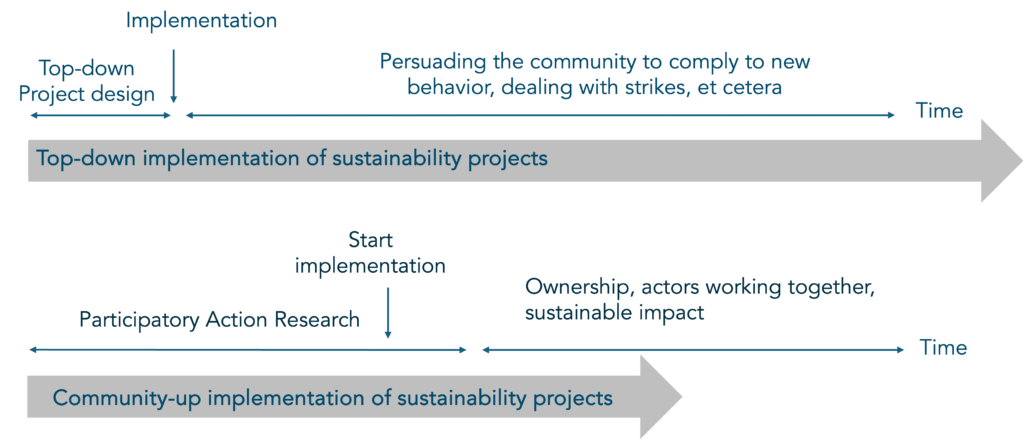“Madelon, what exactly is the difference between Participatory Action Research and other projects we do at the municipality?” Sometimes you get those questions that you can get hell-bent on! I was at a get-together when an employee of Gemeente Utrecht asked me that question. I took a deep breath and began my story, something along the lines of the following.
Being heard, but individually
A very big difference is often found at the start of the PAR. While many (participation) projects often start with “bringing stakeholders together,” a Participatory Action Research (PAR) starts very differently. Indeed, an important part of the start of a PAR is to talk with people individually, often in the form of a semi- or unstructured interview. In this process, the PAR practitioners do not determine what the conversation is about, but the person opposite us. Out of genuine interest and curiosity, we ask questions and let the people involved tell their own story. As a result, they often feel heard and that is an important building block for the feeling of ownership.
Brainstorming about ‘the shared reality’
Then, when we have spoken to all -if not as many- stakeholders individually, we analyze the conversations and create a visualization of the results. That visualization always represents the shared reality according to all those spoken to. We then share this in so-called focus group sessions, in which we let those involved brainstorm together about the results. There is an important difference here: whereas in many projects the people involved often come with the goal of convincing the other person that they are right, ‘armed’ with all kinds of arguments, with PAR it is much more likely that the participants come out of curiosity about the visualization and in the mode of ‘we are going to brainstorm’. By having stakeholders brainstorm and puzzle with one or more visualizations, we divert attention away from: “I have to have the best arguments.” This often yields tremendously beautiful insights! Here again lie some important building blocks of ownership, which you can read in the blog ‘Building a sense of ownership as a source of motivation among stakeholders’.
Co-creation of their own action plans
Gaining insights together and then co-creating action plans together that suit each of the people involved is one of the coolest things to be able to facilitate, because the energy that arises and the ownership and the desire to get to work is contagious and makes people happy!
We no longer have to try our best to win over the other, because we win together.
What a lot of work!
A PAR is often a huge job on the front end, because you spend so much time individually talking to all those involved, analyzing those conversations and making good visualizations. But after almost 10 years of SevenSenses (in March 2023 already!) and 15 years since my first PAR, I can say with full conviction what an enormous added value it has compared to ‘just quickly bring people together’. Below you can see a model I created based on the differences I see between top-down implementation of projects versus community-up co-creation of projects through PAR.

If you think of the horizontal arrows as time, you see that top-down project design is done pretty quickly, if you come up with something with a small club of professionals from behind your desk. Then you often see that those same professionals are struggling as they have to persuade the community to get on board with their project, or if it gets out of hand, even setting up complaint lines and arranging extra meetings where they get told off and yelled at by the audience. People are angry because they are “suddenly” faced with a project, which they feel is not appropriate. It is not for nothing that residents hate public participation evenings, because “the municipality does what they want anyway!”
PAR often takes a lot longer, but by giving all stakeholders the opportunity to help build a sense of ownership and motivation for the solution, the chances of getting lasting impact are greatly increased. Bonus: those involved often also volunteer to help implement their project. That way you often reach your goal much sooner and easier!
Of course, the above raises a huge number of questions. Because what if those involved come up with things we don’t really want because we already have a solution? How do you conduct such action research in the first place?
Now let me tell you SevenSenses offers trainings just for that! Like the PAR Practitioners Program, where you learn all the PAO skills and if desired can apply them directly in your own work under supervision! Curious? Take a look!
Prefer reading how to do Participatory Action Research? Order the ‘handboek Participatief Actieonderzoek’ authored by SevenSenses founder Madelon Eelderink.
